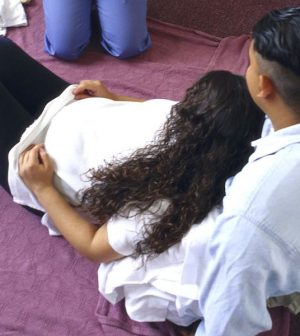- Weight-Loss Drug Zepbound May Lower Heart Failure Deaths
- Nearly 160 Million Americans Harmed by Another’s Drinking, Drug Use
- 1 in 4 Americans Now Struggling to Cover Medical Costs
- Getting Fitter Can Really Help Keep Dementia at Bay
- Skin Patch Could Monitor Your Blood Pressure
- There May Be a Better Way to Treat Hematoma Brain Bleeds
- Chronic Joint Pain Plus Depression Can Take Toll on the Brain
- Living in Space Won’t Permanently Harm Astronauts’ Thinking Skills
- Kids’ Injuries in Sports and at Home: When Is It Right to Seek Medical Attention?
- Human Cell Atlas Will Be ‘Google Maps’ for Health Research
Home Birth Safe for Some, But Not All, Women

Some women really want to give birth at home, but for certain moms-to-be that choice can be risky, a new study suggests.
There are women who have issues that can increase risks in pregnancy but are still likely to have good outcomes delivering at home or in a birth center. Those issues include being over 35, being overweight or having already had a vaginal birth after a cesarean delivery, the researchers said.
Not so for women with other risk factors, such as breech presentation (when the baby is coming out feet first), as well as women attempting their first vaginal birth after cesarean, who may fare worse trying to deliver outside a hospital. In fact, the study found the risk of fetal death was eight to 10 times higher for a home delivery with these risk factors.
“Families who are considering a home or birth center birth now have data to use in making decisions,” said lead researcher Melissa Cheyney, a licensed midwife.
“Many pregnant women do not see one risk-free option,” Cheyney said. They see two different options with some level of risk associated with each, explained Cheyney, an associate professor of medical anthropology at Oregon State University in Corvallis.
A birth center is a home-like facility within the health care system staffed by midwives and nurse-midwives, and sometimes a doctor. These centers, some within hospitals, are designed to make giving birth more natural and less medical.
“Families may be negotiating the possibility of having an intervention in a hospital setting, like a cesarean section, that they do not want or need,” Cheyney said.
But they also understand that having a baby outside a hospital can be risky if an emergency occurs, she said.
“While one study cannot tell an individual which option is the best for them, this research does allow consumers to bring data to conversations that, in the past, may have been driven more by fear than information,” she said.
A little more than 1 percent of all births in the United States happen at home or in a birth center, rather than in a hospital, according to the U.S. Centers for Disease Control and Prevention.
Women who have a low risk for complications are good candidates for home or birth center births if they are supervised by a midwife and have rapid access to a hospital, Cheyney said.
According to the National Association Of Certified Professional Midwives, however, it’s the midwife’s responsibility to assess the risks of a pregnancy and turn care over to a doctor if complications are likely. A midwife should also turn care over to a doctor in a hospital if a home birth turns into a critical situation.
“Home birth is associated with a significant increase in fetal death and some risk for maternal injury,” said Dr. Hal Lawrence, executive vice president and CEO of the American Congress of Obstetricians and Gynecologists.
Women have to understand the risk of birth in any location — a hospital, birthing center or at home — and “realize that there are situations that occur at home that you can’t fix, and they can lose their baby or their life,” he said.
“There is no question that hospital birth is the safest place for mother and baby, so this is a conversation between a women and her doctor,” Lawrence said.
The study included data from more than 47,000 births overseen by midwives.
The researchers looked at 10 common risk factors. These included: giving birth for the first time; mother over age 35; obesity; gestational diabetes; preeclampsia; pregnancy lasting more than 42 weeks; twins; breech presentation; history of cesarean and vaginal birth; and history of only cesarean birth.
“Clearly women have the right to make a medically informed decision about their delivery,” said Dr. Jill Rabin. She’s co-chief of the division of ambulatory care in the Women’s Health Programs-PCAP Services at Northwell Health in New Hyde Park, N.Y.
But delivering at home doubles the risk of the baby dying and triples the risk of the infant having serious mental problems, she said.
Rabin believes that given the risks, the safest options are to give birth in a hospital or in a birth center in or close to a hospital.
“In advance of delivery one can stratify risk factors; however, labor is far from predictable,” she said. “In the event of an emergency, the value of the immediate availability of medical care in order to save the life of the mother or baby cannot be disputed,” Rabin said.
The report was published recently in the journal Birth.
More information
For more on home birth, visit the American Pregnancy Association.
Source: HealthDay
Copyright © 2024 HealthDay. All rights reserved.

-120x134.jpg)



-200x224.jpg)



